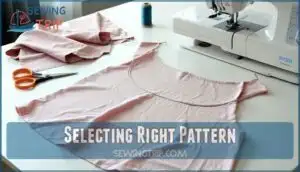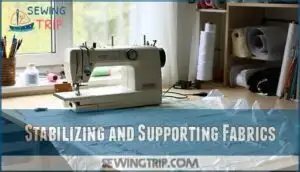This site is supported by our readers. We may earn a commission, at no cost to you, if you purchase through links.
 Sewing delicate fabrics safely requires the right approach from start to finish.
Sewing delicate fabrics safely requires the right approach from start to finish.
You’ll need sharp fabric scissors, fine needles (size 9-11), and high-quality thread that won’t snag.
Set your machine to a shorter stitch length and reduce tension to prevent puckering.
Always use a pressing cloth when ironing, and consider hand-basting seams before machine stitching.
Test your settings on fabric scraps first – this simple step prevents costly mistakes on your main project.
Handle fabrics gently, cutting with long, smooth strokes to avoid fraying.
With proper preparation and technique, even the most challenging silks and chiffons become manageable.
The secret lies in understanding how different fabric weights respond to various stabilizing methods.
Table Of Contents
Key Takeaways
- Test your machine settings on fabric scraps first – You’ll prevent costly mistakes by checking stitch length, tension, and needle compatibility before working on your main project.
- Use the right tools for delicate handling – You need sharp fabric scissors, fine needles (size 9-11), and microtex needles to minimize fabric damage and prevent snagging.
- Stabilize fabrics properly during construction – You should use tissue paper, water-soluble stabilizers, or spray starch to prevent shifting and puckering while maintaining control.
- Choose patterns that work with your fabric’s properties – You’ll achieve better results by selecting loose-fitting designs with minimal seams that don’t stress delicate materials.
Sewing Delicate Fabrics Safely
Working with delicate fabrics can feel intimidating, but you’ll create beautiful, professional-looking garments once you learn the right techniques and use proper tools.
Mastering these skills opens up a world of luxurious materials like silk, chiffon, and lace that transform your sewing projects from ordinary to extraordinary.
Common Challenges
Several challenges plague delicate fabric handling.
Fraying edges unravel quickly when cut or sewn improperly.
Sharp cuts today prevent tomorrow’s unraveling disasters.
Fabric distortion occurs from excessive pulling or incorrect machine settings.
Needle damage creates permanent holes and snags in fine weaves.
Thread breakage disrupts sewing flow, requiring constant rethreading.
Seam puckering results from improper tension or presser foot pressure, creating unprofessional finishes that compromise your project’s appearance.
To avoid these issues, it’s vital to use proper sewing delicate fabrics techniques, such as those found at sewing delicate fabrics, to guarantee a successful outcome with proper handling and delicate care.
Benefits of Mastering The Technique
Mastering delicate fabric sewing transforms your crafting abilities while protecting precious materials from damage.
You’ll develop confidence handling fragile fabrics, reducing costly mistakes that waste expensive silk or chiffon. This expertise opens doors to creating elegant garments previously beyond your skill level.
Understanding delicate fabric techniques is essential for achieving professional results.
- Improved Skills in handling delicate fabric lead to professional-quality results and expanded project possibilities
- Fabric Preservation techniques prevent snags fabric damage, protecting your investment in premium materials
- Time Savings from fewer do-overs and enhanced creativity in pattern selection for fragile fabrics
Selecting The Right Tools
Your needle drawer isn’t just storage—it’s your delicate fabric lifeline.
Fine needles size 9-11 pierce without damaging threads, while sharp scissors create clean cuts that prevent fraying.
Microtex needles minimize puncture marks, and fabric clips won’t leave holes like pins.
| Tool Category | Recommended Type | Key Benefit |
|---|---|---|
| Needles | Fine needles (9-11), Microtex | Minimal fabric damage |
| Cutting Tools | Sharp scissors, rotary cutter | Clean edges, no fraying |
| Stabilizers | Spray starch, sewing stabilizers | Added fabric body |
The table outlines the key benefits of using the right tools for your fabric work, including minimal fabric damage and clean edges.
Choosing Right Fabric
Selecting the perfect fabric sets the foundation for your entire delicate sewing project, determining whether you’ll achieve professional results or face frustrating challenges.
The right fabric choice, combined with proper needle and thread pairing, transforms potentially difficult materials into manageable, beautiful garments that showcase your skills.
Thread and Needle Selection
Your thread choice and needle size determine whether you’ll achieve professional results or create fabric nightmares.
Fine needles sized 60/8 to 70/10 work best for lightweight materials, while Microtex needles prevent snagging with their sharp points.
Match thread weights between 50-60wt to fabric compatibility—silk thread for natural fibers, polyester for synthetics.
Thread selection impacts tension and stitch quality substantially, and understanding the needle size options is vital for superior sewing performance.
Considering Nap Direction
When working with delicate fabrics, checking nap direction prevents uneven color and texture appearance in your finished garment.
Run your hand along the fabric grain to identify nap orientation before cutting.
Align all pattern pieces in the same direction to guarantee consistent fabric appearance.
Proper pattern alignment and cutting strategies minimize fabric slippage during construction, reducing seam damage and maintaining professional results through careful nap consideration.
Fabric Weight and Texture
Fabric weight and texture dramatically influence your sewing success with delicate materials.
Understanding these characteristics helps you choose appropriate handling techniques and prevents costly mistakes during construction.
Consider these essential fabric properties when sewing delicate fabrics:
- Weight Classes – Lightweight fabrics under 4 oz require gentler handling than medium-weight materials
- Texture Types – Slippery fabrics like silk need different stabilization than matte cotton voile
- Fabric Density – Loosely woven materials fray more easily than tightly constructed fabrics
- Fiber Blends – Natural fibers behave differently from synthetic blends during pressing and stitching
- Material Thickness – Ultra-thin fabrics benefit from tissue paper support while handling lightweight fabric layers
Selecting Right Pattern
When selecting a pattern for delicate fabrics, you’ll want to choose designs that work with your fabric’s natural properties rather than against them.
Look for patterns with minimal seams, loose-fitting silhouettes, and simple construction details that won’t stress or damage your precious materials, using delicate fabrics in a way that preserves their integrity.
Considering Hand Sewing
When you’re working with delicate fabrics, hand sewing might be your best friend.
Hand stitches give you complete control over tension and fabric handling, preventing damage that machines can cause.
Here’s when to think about hand stitching:
| Technique | Best For | Thread Choices |
|---|---|---|
| Hand basting | Temporary seams | Cotton or silk thread |
| Running stitch | Lightweight seams | Fine polyester thread |
| Slip stitch | Invisible hems | Matching thread color |
| Blanket stitch | Raw edge finishing | Strong cotton thread |
Hand sewing lets you feel the fabric’s response to each stitch.
You’ll need sharp scissors for clean cuts and proper needle selection – size 9 or 10 work well for most delicate materials.
Remember, hand stitching takes patience, but it’s worth it for perfect results on your treasured fabrics.
Minimizing Seams and Stress
Every sewing project benefits from strategic seam reduction when working with delicate fabrics.
Choose patterns with fewer seams to minimize fabric stress and prevent potential failure points.
Cutting on the fold eliminates center seams, while longer pattern pieces reduce construction joints.
Focus on delicate handling techniques that prioritize stress minimization over complex construction methods.
Strategic seam placement away from high-tension areas protects fragile fibers from damage during wear.
When selecting fabrics, understanding fabric stretch properties is essential for achieving the desired drape and comfort in the final garment, and considering fabric stress is crucial.
Choosing Loose-Fitting Designs
When selecting patterns for delicate fabrics, prioritize loose-fitting designs that provide garment ease and reduce stress on fragile materials.
Tight-fitting garments create tension that can tear seams and compromise fabric drape.
Choose style options with relaxed silhouettes that allow delicate handling while showcasing the natural flow of loose fabrics through thoughtful pattern selection and fit considerations.
Essential Sewing Techniques
Now that you’ve selected the right pattern, it’s time to master the actual sewing techniques that’ll keep your delicate fabrics intact.
These essential methods will transform your approach from nerve-wracking guesswork to confident, precise craftsmanship.
Cutting and Handling Delicate Fabrics
Your tools matter more than you think when fabric cutting delicate materials.
Use sharp scissors and rotary cutters to prevent thread pulling and fraying edges.
Layer tissue paper beneath slippery fabrics like silk or chiffon for better control during seam preparation.
Pattern weights work better than pins for delicate handling, avoiding unnecessary holes.
Work on flat surfaces and move slowly—rushing leads to mistakes and torn fabric, which can be prevented with proper control.
Stabilizing and Supporting Fabrics
Proper stabilizing transforms tricky delicate fabrics into manageable materials.
Place tissue paper or water-soluble stabilizers beneath your fabric before stitching to prevent shifting and puckering. Spray starch temporarily stiffens lightweight materials, making them easier to handle.
Test these fabric stabilizers on scraps first to verify compatibility and avoid unwanted marks or residue.
Understanding the right stabilizer types is vital for achieving professional-looking results with various fabrics, and using the correct stabilizer is key to success, as it helps in preventing puckering.
Using Interfacing and Stay Tape
Interfacing and stay tape transform fragile materials into workable projects. Think of interfacing as your fabric’s backbone—it provides structure without compromising drape. Stay tape acts like invisible armor, reinforcing stress points before they fail.
Understanding proper interfacing techniques is essential for achieving professional results.
- Choose lightweight knit interfacing over fusible types to preserve delicate fabric texture
- Apply narrow fusible stay tape along shoulder seams and necklines for targeted reinforcement
- Test interfacing compatibility on scraps first to avoid heat damage or stiffness
- Cut interfacing pieces slightly smaller than fabric to prevent show-through at edges
- Hand-baste interfacing when fusible options risk damaging temperature-sensitive materials
Pressing and Finishing Delicate Fabrics
Once you’ve mastered cutting and stabilizing delicate fabrics, proper pressing and finishing techniques will transform your project from amateur to professional.
These final steps require just as much care as the sewing itself, since one wrong move with a hot iron can ruin hours of careful work.
Pressing Techniques and Tools
Perfect pressing starts with your iron settings and steam control.
Use cool temperature pressing for delicate fabrics, setting your iron between 275-300°F for silk and synthetics.
A pressing cloth protects against heat damage while maintaining visibility.
Apply gentle pressure without sliding the iron, which prevents stretching, and use these pressing techniques with proper fabric protection to guarantee professional results without compromising delicate materials.
Finishing Seams and Edges
After proper pressing, you’ll need to finish seam edges to prevent fraying and guarantee your garment’s longevity.
French seams provide the cleanest finish for delicate fabrics.
- French seams enclose raw edges completely, creating a professional appearance
- Rolled hems work perfectly for lightweight scarves and sheer curtains
- Bias binding adds structure while protecting edges from stretching
- Mock French seams offer similar benefits with less bulk
- Hong Kong finish uses bias strips to bind edges cleanly
Choose your seam finishing method based on fabric weight and garment style for best results.
Hemming and Binding Delicate Fabrics
Creating flawless hemming and binding requires finesse with delicate materials.
Use rolled hems with specialized hemming feet for professional results. Blind hems work well for invisible finishes, while fabric binding protects raw edges beautifully.
Practice the rolled hem technique on scraps first. Stay stitching prevents stretching during hemming processes.
Mastering seam finishes techniques is essential for achieving professional-looking results with delicate fabrics, and it requires a good understanding of delicate materials and seam finishes.
Tips for Successful Sewing
You’ll achieve the best results with delicate fabrics when you maintain your tools properly and follow proven techniques consistently.
Success comes from practicing on fabric scraps first, keeping your workspace organized, and never rushing through the delicate sewing process.
Maintaining Tools and Equipment
While maintaining your equipment seems mundane, it’s the backbone of successful delicate fabric sewing.
Your tools directly impact your results and fabric integrity.
Essential maintenance tasks include:
- Sharp Scissors – Replace or sharpen every 6 months for clean cuts
- Needle Care – Change sewing machine needles every 6-8 hours of use
- Thread Management – Store thread properly to prevent tangling and breakage
- Sewing Machine maintenance – Clean lint, oil regularly, and calibrate tension settings
Troubleshooting Common Issues
When fabric tears or thread breaks repeatedly, you’re likely using dull needles or excessive tension.
Needle damage creates snags and fabric stretching, while seam distortion indicates incorrect presser foot pressure.
Here’s your quick troubleshooting guide:
| Problem | Cause | Solution |
|---|---|---|
| Fabric tears, fraying edges | Dull needle, wrong size | Replace with fresh Microtex 60/8 |
| Thread breaks, puckering | High tension, fast speed | Reduce tension, sew slowly |
| Seam distortion, fabric stretching | Heavy presser foot pressure | Lighten pressure, use walking foot |
To resolve these issues, remember that correct presser foot pressure and the right needle size are crucial for preventing fabric tears and thread breaks, ensuring a smooth sewing experience with minimal seam distortion.
Best Practices for Sewing Delicate Fabrics
Success with sewing delicate fabrics requires patience and preparation.
Start by testing your sewing machine settings on fabric scraps, adjusting thread tension and stitch length accordingly.
Choose microtex needles and high-quality threads that match your fabric weight.
Always use appropriate stabilizer options like tissue paper or spray starch to prevent snags and tears while protecting delicate fabric throughout the process.
Frequently Asked Questions (FAQs)
What is the best stitch for delicate fabric?
Picture delicate silk threads dancing under your needle’s gentle touch. Use straight stitches with 5-2mm length, reduced tension, and slow speed. This prevents puckering while maintaining fabric integrity perfectly.
What precautions should be taken when washing delicate fabrics?
Hand wash in cool water with gentle detergent, or use your machine’s delicate cycle with a mesh bag. Always air dry—heat can damage fibers permanently.
What size needle do I use for delicate fabric?
Don’t put the cart before the horse—you’ll need fine needles sized 9/65, 10/70, or 11/75 for delicate fabrics. These smaller sizes prevent snagging and tearing while creating precise, clean stitches.
How to store delicate fabrics properly?
Store delicate fabrics flat or rolled on tubes, never folded.
They should be kept in breathable cotton bags or acid-free tissue paper.
This storage method should be in cool, dry places away from direct sunlight to prevent fading and deterioration.
Can delicate fabrics be machine washed?
Like delicate silk threads that require gentle handling, your precious fabrics can survive machine washing.
Use gentle cycles, mesh bags, and cold water.
Hand washing remains the safest route for truly fragile pieces.
What causes thread breakage during sewing?
Thread breakage happens when you’re using old or wrong-sized needles, mismatched thread weights, incorrect tension settings, or sewing too fast. Always use fresh, properly-sized needles and compatible thread weights.
How to remove wrinkles without damage?
Hot irons damage 75% of delicate fabrics permanently.
Use low heat with a press cloth, or try steaming vertically.
Test temperature on scraps first.
Hang garments naturally to minimize wrinkles before pressing, using low heat to prevent damage.
Are overlock machines safe for delicates?
Overlock machines can handle delicate fabrics, but you’ll need proper adjustments. Use lightweight thread, reduce presser foot pressure, and test on scraps first to prevent stretching or puckering issues.
Conclusion
Like a gentle whisper that carries the weight of wisdom, mastering delicate fabrics transforms your sewing journey from frustrating to fulfilling.
Remember that sewing delicate fabrics safely isn’t just about technique—it’s about patience and preparation.
Take your time with each step, test your settings thoroughly, and trust the process. With these expert tips in your toolkit, you’ll confidently tackle even the most challenging silks and chiffons, creating beautiful garments that showcase your growing skills and attention to detail.
- https://blog.treasurie.com/prewash-fabric-before-sewing/
- https://www.craftsy.com/post/how-to-wash-fabric-before-sewing/
- https://blog.megannielsen.com/2012/10/the-importance-of-ironing-pressing-your-sewing-creations-2/
- https://tissura.com/articles/sheer-fabrics
- https://www.abcsewingmachine.com/blogs/features/56261317-choosing-the-right-sewing-machine-needles-for-your-projects
















